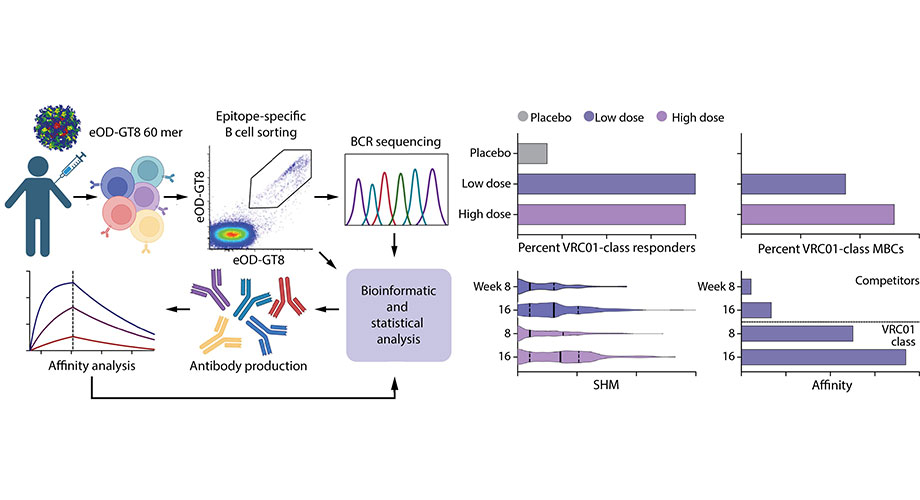Washington (Dec 08, 2022) - The George Washington University Vaccine Research Unit in partnership with Scripps Research, IAVI, Fred Hutchinson Cancer Center (FHCC) and the National Institutes of Health, National Institute of Allergy and Infectious Diseases Vaccine Research Center published the results of their Phase 1 Clinical Trial in Science. The results show critical new insights into their novel vaccine strategy, which involves a stepwise approach to producing antibodies capable of targeting a wide range of HIV variants.
The trial, known as IAVI G001, tested the first stage in a multi-stage HIV vaccine regimen the researchers are developing. The trial results show that the vaccine had a favorable safety profile and induced the targeted response in 97% of people who were vaccinated. Importantly, the study also provides a detailed immunological analysis of the vaccine responses.
“HIV has continued to be a difficult virus to create a vaccine for given its ability to mutate and quickly evade the immune system,” David Diemert, professor of medicine at GWU School of Medicine and Health Sciences, said. “The findings from this trial bring new hope to stopping HIV and may help find vaccines for other difficult infectious diseases as well.”
The novel vaccine strategy that was tested in this trial is focused on producing broadly neutralizing antibodies (“bnAbs”), which are a rare type of antibody that can fight and protect against many different variants of a virus, including HIV.
The researchers in the study are using a procedure known as ‘germline targeting’ to eventually produce bnAbs that can protect against HIV. The first step of germline targeting involves stimulating the rare immune cells—known as bnAb-precursor B cells—that can evolve into the cells that produce the bnAbs needed to block the virus. To accomplish this, the researchers designed a customized molecule—known as an immunogen—that would “prime” the immune system and elicit responses from these rare bnAb-precursor cells.
For this clinical trial, a novel method of sampling lymph nodes was developed by the clinical and biorepository teams at GW, FHCC and IAVI, which included ultrasound-guided fine needle aspiration of lymph nodes near the injection site. “This is the first time such a technique has been used routinely in a vaccine clinical trial,” Jeffrey Bethony, professor of microbiology, immunology and tropical medicine at GW SMHS said. “It enabled us to acquire a cell population critical to germline stimulation that do not circulate but remains sequestered in lymph node tissue.”
The GW VRU has partnered with IAVI on two other HIV vaccine-related Phase I clinical trials over the past five years, serving as a lead site, central biorepository and support unit. In addition, the unit has conducted a number of other clinical vaccine trials to date, including a Phase III trial to test the now FDA-authorized COVID-19 vaccine from biotechnology company Moderna; a Phase II clinical trial for a COVID-19 vaccine booster from the biopharmaceutical company Sanofi; and a Phase I trial of a vaccine to prevent Lassa fever, an acute, animal-borne viral disease endemic to parts of West Africa.
This work was supported by the Bill & Melinda Gates Foundation Collaboration for AIDS Vaccine Discovery; the IAVI Neutralizing Antibody Center; NIAID; Scripps Center for HIV/AIDS Vaccine Immunology and Immunogen Discovery and Scripps Consortium for HIV/AIDS Vaccine Development; and the Ragon Institute of MGH, MIT, and Harvard. Other collaborating organizations include Duke Human Vaccine Institute, Karolinska Institutet, and La Jolla Institute.
Research at the IAVI Neutralizing Antibody Center that contributed to the development of the vaccine antigen eOD-GT8 60mer was also made possible by the government of the Netherlands through the Minister of Foreign Trade & Development Cooperation and through the generous support of the American people through PEPFAR through USAID. The contents are the responsibility of IAVI and Scripps Research and do not necessarily reflect the views of PEPFAR, USAID, or the United States government.
Much of this release was pulled from IAVI and Scripps press release: https://www.scripps.edu/news-and-events/press-room/2022/20221202-schief-hiv.html
-GW-


